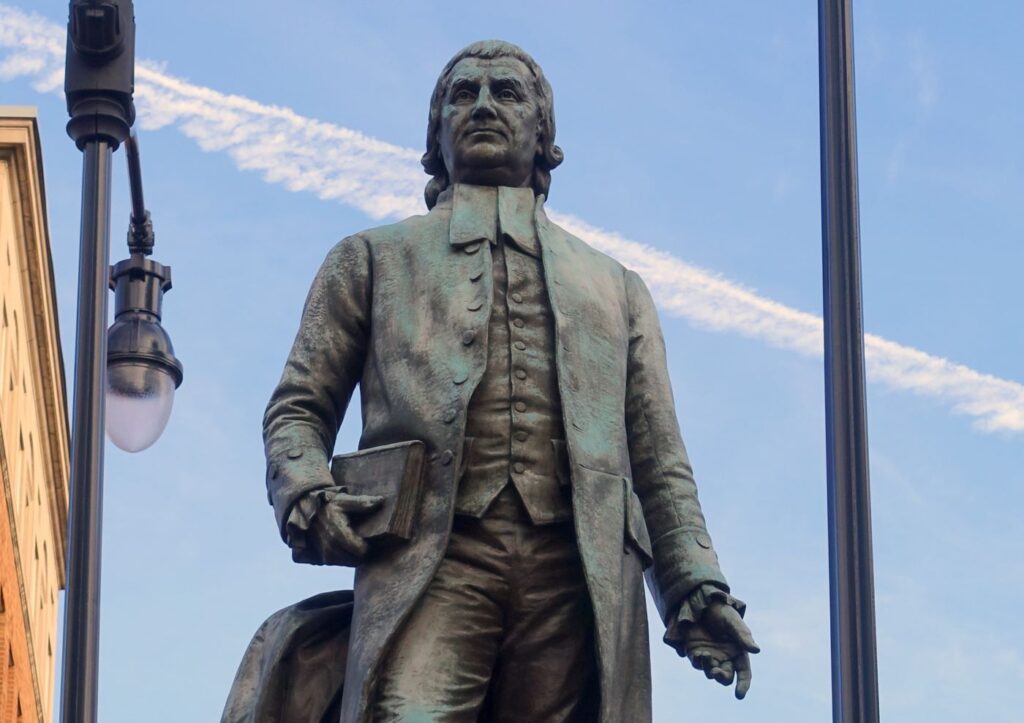This essay was adapted from a keynote delivered at the Witherspoon Institute’s twentieth-anniversary celebration in Princeton on October 25, 2023.
I went to a nearby college in the early 1990s at a time when debates were raging about a phenomenon then called “political correctness.” An editorial cartoon at the time featured three left-wing professors expressing their outrage at the debate. As I recall it, one was saying, “There’s no such thing as political correctness!” “There’s no climate of intolerance here,” said another. The third added, “And anyone who says there is should be kicked off campus!”
It’s an image I have had occasion to recall during our more recent debates over “cancel culture” and “wokeness.” Some social trends inspire critique and defense; but in the argument over cancel culture, where a defense should be there is typically a denial that cancel culture exists at all.
This denial is increasingly at odds with the evidence. The Cato Institute found in 2020 that 62 percent of people agreed that “the political climate these days prevents me from saying things I believe because others might find them offensive.” Conservatives were most likely to agree, but a very large majority of moderates agreed, too. “Strong liberals” were the only group that had a majority in disagreement, and even 42 percent of them agreed. This sentiment is not, as the doubters would have it, confined to the rich and the privileged.
Start your day with Public Discourse
Sign up and get our daily essays sent straight to your inbox.Critics of cancel culture are not simply averse to criticism, either, though the cancel culture deniers claim that is all there is to their critique. Cato also asked, “Are you worried about losing your job or missing out on job opportunities if your political opinions became known?” A third of employed respondents said yes—including 22 percent of blacks and 38 percent of Latinos. These respondents don’t seem to be reacting to a hardening of taboos against comments that nearly everyone sees as bigoted. They’re not expressing unhappiness because of an increasing concern for simple politeness. They’re not aging Baby Boomers who can’t handle social media, which is the dismissal former President Barack Obama bizarrely received when he criticized left-wing purity enforcers. Cato found that people aged eighteen to twenty-nine were the most worried about job repercussions from their opinions.
The findings are more consistent with what the critics of cancel culture have been saying: the line of unacceptability is constantly, rapidly, and unpredictably shifting, and sanctions for crossing it are applied arbitrarily but sometimes harshly. To deny a rising climate of intolerance in the face of such findings requires believing that most people are wrong, and not about some technical point or some abstract matter far removed from everyday life, but about their own experiences.
We are becoming less tolerant of differing opinions, less inclined to judge them with open minds or at least charity, and more inclined to experience disagreement as an attack on our very sense of self: a kind of spiritual violence. Hence all of the invocations of an expansive concept of “safety.” And it’s important to note that this problem is not confined to college campuses, as the political correctness of the 1990s could plausibly be said to be. The virus has escaped its original environment, even if it remains more prevalent there. It now afflicts publishing houses and newspapers, celebrities and business executives, janitors and high-school seniors.
We are becoming less tolerant of differing opinions, less inclined to judge them with open minds or at least charity, and more inclined to experience disagreement as an attack on our very sense of self: a kind of spiritual violence.
The consequences of this trend are many and almost entirely negative. They include hardened political and social divisions—but worse, they require a reduction of our ability to argue our way across and through those divisions. Again, this is not a problem isolated to universities, but it is particularly acute and enervating there.
It combines there with another baleful development. “Left-leaning” was once an accurate description of college faculties in the United States. In 1990, a survey found that professors who considered themselves on the Left outnumbered their counterparts on the Right by more than two to one. Since then, the academy has been moving toward becoming an ideological monoculture. By 2017, progressives had a five-to-one advantage. And there is reason to believe the tilt has become even more pronounced in succeeding years.
The lack of right-of-center professors undermines higher education. It means that some conservative perspectives go unexplored and conservative arguments unexamined. It stifles debate, since even professors and students with reservations about campus orthodoxies will hesitate to voice them if they think they’re alone. And it perpetuates itself by creating a climate that discourages bright young conservatives from becoming academics themselves.
Both of these trends—ideological uniformity and ideological intolerance—reinforce each other. The dearth of tenured conservatives makes it possible to ostracize the remaining ones, and the ostracism contributes to the dearth. Both of these trends have a further regrettable effect: they encourage an anti-intellectual spirit among conservatives.
All of this may sound pretty bleak. I’m here to tell you that it’s actually worse.
For one thing, and contrary to an implicit point of that long-ago cartoon, it is not just the faculty that acts as ideological enforcers. College administrators have too often become a force for a kind of bureaucratized ideological bullying.
Even more importantly, wokeness and the left-wing near-monopoly on campus are not the only or even the most insidious threats to the university. A utilitarian spirit, one that asks of education only what it adds to future earnings or the gross domestic product, can also undermine the enterprise. But this tendency has grown much stronger in our time—not least because of people who sought to promote education and its increased subsidization and found that the most effective means of doing so was to cast its benefits in strictly economic terms.
This is not to say that the desire to reap such benefits from education is wholly misguided.
Yuval Levin in A Time to Build has talked about the “three intermingled cultures” of the university: one centered on moral activism, one on professional development, and one on liberal education. All of these cultures have deep roots, and among them, there are deep tensions.
Those focused on professional development sometimes see both moral activism and the liberal arts as impractical luxuries. The moral activists—in our day, that is mainly the woke—can disdain the liberal arts and professional development as forces for complacency in the face of injustice. And champions of the liberal arts find it tempting to dismiss the moralists and the professional strivers as different types of materialists and philistines.
But if the tensions are ever-present, the balance of forces changes over time. That culture of liberal learning is typically the weakest of the three; in our time it has been shrinking, and so it is its value that most needs to be defended. I speak of an education in the good, the true, and the beautiful; an education that requires us to ask the deepest human questions, to provide an account of what we believe and why, and perhaps even to change our deepest beliefs; the form of education that Aristotle wrote “should be taught to children, not because it is useful or necessary, but because it is fit for a free person and noble.”
The goal of this kind of education is the examined life. Jennifer Frey has written about it:
We need bright young people who can design and build bridges, run successful businesses, and write code for our computers. But surely we also want these people to have some sense of the good of these endeavors beyond the works themselves. Where is the bridge taking people? What product is the business making, and are its effects on those who consume it good or bad? How does the algorithm change how we think and live, and are these changes desirable? The technical arts are not aimed at asking or answering these latter questions, but we dismiss or retreat at the cost of our deepest human needs and aspirations.
I take it that Frey does not deny that a liberal education can have practical and economic benefits. Nor do I. Like most of the people I work with in journalism, I never went to journalism school, and I have never found that colleagues who did enjoy, on average, any advantage from it; but the knowledge and habits of thought I picked up while working toward my undergraduate history degree have aided my work in some specific ways I can recall, and doubtless in many ways of which I am barely conscious. Much like happiness, though, these benefits are a byproduct of an activity undertaken for other reasons.
Liberal learning is so called because it is, as Aristotle put it, fit for free people and, one might say, helps fit people for freedom. It liberates: liberates from thoughtless convention, from mistaken prejudice, from mental laziness. But it is also conservative, concerned with the transmission of an intellectual and cultural inheritance, inculcating within students gratitude and even a sense of custodial responsibility for it. The fact that young people need to be formed, intellectually and morally, places a limit on dreams of progress from one generation to another. In an important sense, we start from scratch with every baby.
Much of that formation is, of course, the work of families and churches more than of formal education. It is families who principally undertake the crucial tasks of protecting the next generation from the world while protecting the world from the next generation.
Nor is the examined life the property of universities. Attending college is neither a necessary nor sufficient condition for the examined life, but it can and should help students achieve it. When that doesn’t happen, something is missing in a university—and in society.
So far, I have been lamenting what is lacking in the academy and our intellectual life generally. This is the point at which a speaker either lays out his solution or artfully evades the truth that he has none to offer. I choose a third option, and that is to commend a way of thinking and acting that will strengthen what is healthful in our culture: the Witherspoon way. It will not fix what ails the universities. But it can serve as a model for how to go about reforming our culture.
First, the Witherspoon Way starts with the commitment to the bedrock principle of universal human dignity. All human beings, simply by virtue of being human, have intrinsic worth and deserve basic rights and respect: regardless of race, regardless of religion, regardless of nationality, regardless of size or age or condition of dependence. In seminars, in articles, in research projects, Witherspoon explores what this principle entails and what it presupposes: what it means for religious freedom, for immigration, for ethics in war, for the regulation of biotechnology, and for much more.
Second, the Witherspoon way includes a commitment to persuasion. This is not just because persuasion is efficacious, because we lack the power to force our views on others. It is not because it makes us look thoughtful, fair-minded, or winsome. It follows from our respect for our fellow citizens and human beings, for their free wills and intellects. We do not attempt to win spurious victories in debates through name-calling, through the distortion of rival positions, or through merely emotional appeals. We seek free assent, not blind adherence or sullen acquiescence, to our convictions.
Third, it requires humility. As we persuade, we are open to being persuaded. Our minds may change. Important questions are open and important conclusions provisional. Public Discourse has hosted great debates about how we should understand the American Founding in our time, about nationalism, about varieties of conservatism. Years ago, I attended a Witherspoon conference that brought together scholars with a wide range of views on monetary policy; their discussions and arguments still inform my writing on the subject.
Fourth, the Witherspoon Way is one of prudence, balancing things that are often in tension. Advocacy and scholarly rigor. Faith and reason. Freedom and virtue. Principle and coalition-building. Conviction without partisanship. Speaking to scholars and lay readers. Long-term investments and projects that make an immediate splash. A willingness to speak unpopular truths while avoiding the provocation of outrage for its own sake. Even those of us who favor this approach do not always achieve it as well as Witherspoon has.
The Witherspoon Way is one of prudence, balancing things that are often in tension. Advocacy and scholarly rigor. Faith and reason. Freedom and virtue. Principle and coalition-building. Conviction without partisanship.
Fifth, the Witherspoon Way takes seriously the challenge of forming young people. It exposes them to well-constructed arguments, offers them models of intellectual virtues such as self-restraint, and even provides mentors to those who are open to it. It kindles in them an interest in the great questions that much of modern life is organized to make people forget; and it introduces them to, or deepens their acquaintance with, some of the best answers that have been given.
Sixth, the Witherspoon Way points to an institutional model for reforming universities. People who recognize some of the genuine defects of higher education in the U.S. have been pursuing several strategies to remedy them. Not all of those strategies are equally promising. One strategy that has been extremely if puzzlingly popular, has been to offer great gobs of money to university administrations at odds with a proper understanding of education, while also complaining about their behavior.
Another has been to speak of burning down the universities. That would be destructive if pursued—also superfluous, since some of them seem to be run by arsonists already—but, since those who say this rarely have any actual plan of action, it is merely frivolous. And still another has been to regulate universities into good behavior. Some regulations may even be sensible, especially as applied to public universities; but an overwhelmingly left-wing professoriate cannot be legislatively prodded into giving students a fair account of other points of view. Nor can administrations that do not value education, properly understood, be forced by law to do so.
A far better approach is to create or strengthen institutions that operate within or beside universities—offering support for administrators, professors, students, and alumni alike, in the form of fellowship, encouragement, and, as it were, remedial education in non-approved viewpoints. Such institutions do not seek to dominate their environment but to exert influence over it, and they exert that influence by being good, true, and beautiful themselves. The Witherspoon Institute is one such organization, and let us hope that it comes to have many more sisters.
There is a case for cursing the darkness. But it is better to light a candle, and better still to light many. I thank everyone here for supporting the Institute and thereby maintaining the light.
Image is in the public domain thanks to Wikimedia Commons. Image has been cropped.














